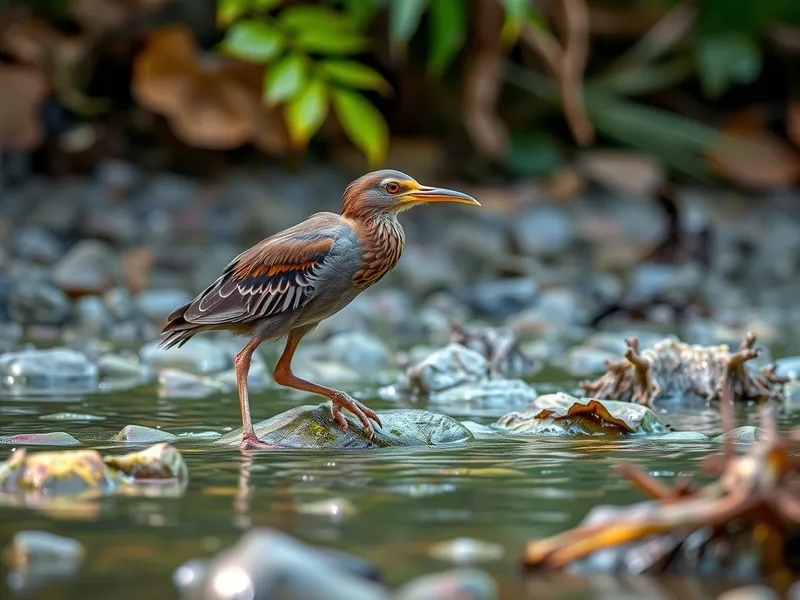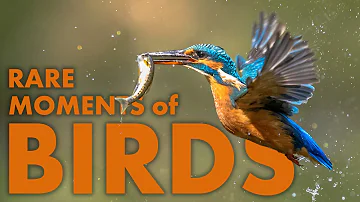
Sunbittern
Eurypyga helias

Meet the Sunbittern
The Sunbittern is a striking, medium-sized bird native to the tropical regions of Central and South America. It is renowned for its unique wing pattern, which, when spread, displays vivid eye-like markings in shades of orange, yellow, and black—resembling a rising sun. Sunbitterns are solitary and secretive, often found near forested streams and riverbanks where they hunt for aquatic prey. Their cryptic plumage helps them blend into their surroundings, making them difficult to spot when their wings are closed.
Classification
Bird
Habitat
Tropical forest streams and riverbanks
Diet
Carnivore
Lifespan
15-20 years
Conservation
Least Concern
Weight
170-220 g
📖Fascinating Facts
Spectacular Display
The Sunbittern's wing display is used to startle predators and rivals, revealing bright eye spots that mimic dangerous animals.
Aquatic Hunter
It hunts along streams and shallow rivers, feeding on insects, crustaceans, amphibians, and small fish.
Unique Family
The Sunbittern is the only living member of its family, Eurypygidae, making it highly distinctive among birds.
📋Detailed Description
The Sunbittern (Eurypyga helias) is a medium-sized bird, measuring 43–48 cm (17–19 in) in length and weighing between 170–220 grams. It is characterized by its slender body, long neck, and strikingly elongated legs and toes, which are well-adapted for wading in shallow water. The plumage is predominantly cryptic, with intricate gray, brown, and black barring that provides excellent camouflage among leaf litter and riverbanks. The most distinctive feature is the spectacular display of its wings: when threatened or during courtship, the Sunbittern fans its wings to reveal large, vividly colored eye-spots in orange, yellow, and black, which mimic the eyes of larger animals and may deter predators. The head is adorned with a fine, white supercilium and a dark eye-stripe, while the bill is straight, slender, and slightly decurved, suited for probing and grasping prey. The tail is relatively long and rounded. Sunbitterns are primarily solitary and highly territorial, often seen walking slowly and deliberately along streams. Their movements are graceful and deliberate, and they are capable of a unique 'sun dance' display, involving wing and tail spreading. Their vocalizations are generally soft, consisting of whistles and hissing calls, though they are more often heard than seen. The species is sexually monomorphic, with males and females appearing similar, though males are slightly larger on average. Three recognized subspecies exist, differing subtly in plumage and range: E. h. helias, E. h. major, and E. h. meridionalis.
💡 Did you know?
The Sunbittern shares a close evolutionary relationship with the Kagu of New Caledonia, despite living on opposite sides of the world.
🔬Research & Sources
Wikipedia Summary
The sunbittern is a bittern-like bird of tropical regions of the Americas, and the sole member of the family Eurypygidae and genus Eurypyga. It is found in Central and South America, and has three subspecies. The sunbittern shows both morphological and molecular similarities with the kagu of New Caledonia, indicating a Gondwanan origin, both species being placed in the clade Eurypygiformes.
Last Modified: 5/26/2025
🎭Behavior & Social Structure
Sunbitterns are diurnal and exhibit crepuscular activity peaks, foraging primarily at dawn and dusk. Their foraging technique involves slow, stealthy stalking along water edges, where they use their sharp eyesight to detect prey such as aquatic insects, crustaceans, small fish, amphibians, and occasionally terrestrial invertebrates. They employ a rapid thrust of the bill to seize prey, often washing it in water before consumption. Sunbitterns are highly territorial, defending linear stretches of stream or riverbank with visual displays and vocalizations. They are generally solitary outside the breeding season, but pairs may maintain adjacent or overlapping territories. When alarmed, they freeze or crouch, relying on their cryptic plumage, but if further threatened, they perform the dramatic wing display. They are adept at walking and wading, rarely swimming or flying unless disturbed. Flight is strong but typically low and direct, with rounded wings and a steady, undulating pattern. Sunbitterns are known for their meticulous preening and sunning behaviors, often spreading their wings to absorb sunlight.
👶Reproduction & Life Cycle
Sunbitterns are monogamous, forming long-term pair bonds. Courtship involves mutual displays, including synchronized wing spreading and bowing. Breeding typically coincides with the onset of the rainy season, varying locally but generally occurring from March to September. The nest is a shallow platform constructed of sticks, leaves, and moss, usually placed 1–3 meters above water in tree branches or dense vegetation. The female lays 1–2 eggs, which are pale with brown and gray blotches. Both parents share incubation duties, which last 27–30 days. Chicks are semi-precocial, hatching covered in down and able to leave the nest within a few days, though they remain dependent on parental care for several weeks. Both parents feed the chicks by regurgitation and protect them with the wing display if threatened. Fledging occurs at around 30–35 days post-hatching.
🛡️Adaptations & Survival
The Sunbittern exhibits several unique adaptations. Its cryptic plumage provides camouflage in dappled forest light, while the dramatic wing eye-spots serve as anti-predator displays and play a role in social signaling. The long toes and legs facilitate wading and balance on uneven, slippery substrates. The bill is specialized for precision feeding on small, agile aquatic prey. Behavioral adaptations include the 'sun dance' and sunning posture, which may aid in feather maintenance and parasite control. The species' solitary, territorial nature reduces competition for food resources. Phylogenetically, the Sunbittern shares morphological and molecular traits with the Kagu (Rhynochetos jubatus) of New Caledonia, supporting a Gondwanan origin and placement in the order Eurypygiformes, a lineage distinct from true bitterns and herons.
📚Research Sources
🎨Cultural Significance
The Sunbittern is admired for its beauty and unique wing display, often featured in ecotourism and birdwatching literature in Central and South America. While it does not have a prominent role in indigenous mythology or folklore, its striking appearance has inspired local names and occasional symbolic uses, such as representing the diversity of Amazonian wildlife. In some regions, it is considered a symbol of pristine riverine habitats.
🔬Recent Research & Discoveries
Recent molecular phylogenetic studies have clarified the Sunbittern's evolutionary relationships, confirming its close affinity with the Kagu and supporting the ancient Gondwanan lineage hypothesis. Ongoing research focuses on its behavioral ecology, particularly the function of its wing display in both anti-predator and social contexts. Studies using camera traps and acoustic monitoring are improving knowledge of its population density and habitat use. There is growing interest in the Sunbittern as a model for understanding convergent evolution in wading birds. Conservation research is monitoring the effects of riverine habitat fragmentation and climate change on its distribution.
🎥Wildlife Videos

Wild Colombia - Fantastic Creatures | The Lost Eden | Free Documentary Nature
Wild Colombia - Fantastic Creatures | The Lost Eden | Free Documentary Nature Watch 'Wild Colombia Revealed' here: ...
Free Documentary - Nature

The Incredible Wildlife Living At Our Equator | Equator Specials
The sun shines most powerfully at the Equator, here it is able to power extraordinary life. From the large trees covering the ...
All Out Wildlife

David Attenborough Presents: Tasmania - Weird & Wonderful | Free Documentary Nature
David Attenborough presents: Tasmania - Weird & Wonderful | Wildlife Documentary Watch 'David Attenborough's Ant Mountain' ...
Free Documentary - Nature

Incredible 4K Nature Scenes Narrated By David Attenborough | BBC Earth
Relax with extraordinary 4K nature footage narrated by Sir David Attenborough, the voice of natural history for over 70 years.
BBC Earth

The Wonder of America's National Parks | MEGA EPISODE Season 1 Full Episode
America's National Parks depicts the adventure, beauty and wonder of natural spaces. Each park is a valuable and important ...
National Geographic

AMAZING LIFE OF BIRDS | Full Wildlife Documentary
This video is dubbed in 8 languages: Welcome to Amazing World of Birds — a ...
Wildlife Film Central
🌍Habitat Information
The Sunbittern typically inhabits Tropical forest streams and riverbanks environments. Sunbitterns have adapted to their environments with specialized features and behaviors.
Primary Habitat:
Tropical forest streams and riverbanks
More detailed habitat information will be available soon.
🛡️Conservation Status
The Sunbittern is currently classified as Least Concern. Conservation efforts are crucial for preserving this species for future generations.
Common Threats:
- 🏠Habitat loss and fragmentation
- 🌡️Climate change impacts
- 🎯Hunting and poaching
- 🏭Human-wildlife conflict
⚠️Threats & Conservation Challenges
Currently classified as Least Concern by the IUCN, the Sunbittern faces localized threats from habitat loss, particularly deforestation, water pollution, and alteration of riverine habitats due to agriculture, mining, and infrastructure development. Fragmentation of forested waterways may limit suitable breeding and foraging sites. The species is sensitive to human disturbance, especially during nesting. However, its broad range and adaptability to secondary forests and disturbed habitats have buffered it against severe population declines. No significant hunting pressure is reported, and the global population is considered stable, though local declines may occur where habitat degradation is severe.
🔬Scientific Classification
Scientific Name
Eurypyga helias
Classification Hierarchy
🔍 About Taxonomic Classification
Taxonomic classification is a hierarchical system used by scientists to classify and organize living organisms based on shared characteristics and evolutionary relationships.
The system moves from broad categories (Kingdom) to increasingly specific ones, with each animal's scientific name typically consisting of its Genus and species.
📝Community Notes
Share your observations and insights about the Sunbittern with our community of wildlife enthusiasts.
Join Our Community
Sign in to share your observations and connect with fellow wildlife enthusiasts.
Sign In to ContributeNo community notes yet
Be the first to share your observations about the Sunbittern!
Explore Sunbittern
Select a tab above to learn more about this amazing animal.
📸Photo Gallery
No photos available for this animal yet.
🌟Discover More Wildlife
Continue your journey of discovery with more fascinating animals from our database
